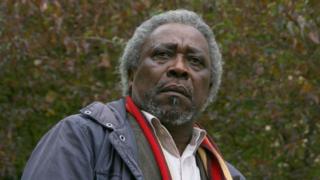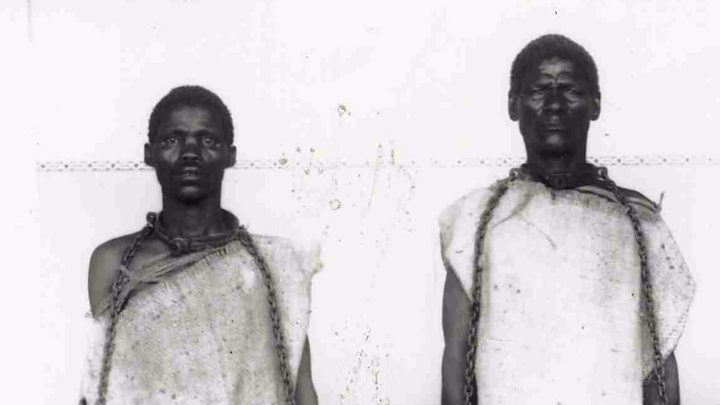A 40-year search for a skull in Germany
Pressure is growing on Germany and the UK to return to Africa skulls taken as trophies and for discredited racial research more than a century ago, writes the BBC’s Damian Zane.
A Tanzanian based in Germany, Mnyaka Sururu Mboro, has been searching for the lost skull of Mangi Meli for 40 years.
Mangi Meli, a chief from the north of what is now Tanzania, was executed in 1900 for his role in a rebellion against German colonial rule.
After he died, his body was decapitated and his head was taken to Germany.
The exact whereabouts of his skull are not clear, but the admission by the Berlin-based Prussian Cultural Heritage Foundation (known by its German initials SPK) that it has far more human remains from Tanzania in its archive than previously thought has left Mr Mboro more hopeful.
He is from the same region in Tanzania as Mangi Meli and in 1977, before he left to study in Germany, he promised his grandmother that he would retrieve the skull.
Researchers have found 200 Tanzanian remains in the collection, many of them skulls, that were taken while the country was under German rule, which is more than double the original estimate.
Since October 2017 they have been trying to establish the origins of the bones in the archive, which number in the thousands.
Their project began a year after German journalists uncovered the extent of the remains from the country’s former colonies now held by the SPK.
Researchers have also identified 900 skulls from Rwanda, and an estimated 400-500 from Togo and Cameroon – these were all countries that were part of the German empire between 1884 and 1918.
Remains that were taken from Namibia did not make it into the SPK’s collection.
Sometimes the skulls were taken as trophies, but more often the human remains were transported to aid with now discredited research into racial classification.
In 1899, German anthropologist Felix von Luschan sent out a message encouraging people to collect remains from the country’s colonies saying that “even an amateur can procure anthropological material.
“He should always bear in mind that each single skull that he brings with him is more important than a general description of a type. Any occasion to rescue a large number of skulls from being destroyed in the ground or in a fire should be zealously used, without causing offence.
“The [ethnology] museum will soon be newly sorted in an honourable way and will then be the most beautiful and great monument for our Schutztruppe [German colonial troops].”
The von Luschan collection, which originally contained 6,300 skulls, ended up with the SPK in 2011 after passing through several hands with some of the remains and much of the information relating to the bones having been lost.
The museum body now sees it as its mission to find out the origin of all the skulls and return them if they were taken in what it calls a “context of injustice”, for example if the skull belonged to someone who was executed.
Proper burials demanded
Tanzania’s Foreign Minister Augustine Mahiga has said his government wants to discuss the return of the remains, but they want to go beyond the SPK’s idea of the “context of injustice”.
“In my opinion, when you talk about human bodies you talk about human dignity. It’s like saying how important is dignity to Tanzania. You don’t take someone’s body to do research,” Abdallah Saleh Possi, Tanzania’s ambassador to Germany, told the BBC.
“If there was a context of injustice – such as execution – then you cannot defend it, but even if they were not taken in the context of injustice, who consented that these bodies should be transported?”
And in that light, the ambassador asks: “Why shouldn’t these remains be returned? Who needs them there? Why shouldn’t they be accorded a proper burial?”
A proper burial is what is on the mind of Mr Mboro.
He says that if he can return Mangi Meli’s skull to Moshi in the north of Tanzania then he “will feel at peace” as the chief’s dismembered body needs to be complete.
“They have to bring the remains back to the people who are still suffering from the loss,” he adds.
Mr Mboro, who now lives in Berlin, comes from the same community as the executed chief and grew up on the stories of his bravery.
His grandmother told him how he remained defiant up to his death.
Mangi Meli was hanged with 18 other rebels but he took seven hours to die, which was seen as proof of how strong he was, Mr Mboro says.
‘Ignorance and resistance’
In 1977, when he was 27, Mr Mboro won a place to study civil engineering in Germany and he made a pledge to his grandmother.
“When I went to say goodbye to her she jumped up and went outside the hut to tell all the villagers to come,” Mr Mboro remembers.
“She told them, ‘You see my man is going to Germany and he will bring back the skull of Mangi Meli’, and I had to promise.”
But the village is still waiting.
Mr Mboro has spent the last four decades pushing the authorities to open up the archives and look into the collections of human remains.
At first it was ignorance rather than resistance that hampered the search, he says.
“Everyone I was asking said they didn’t know anything about the history.”
But eventually he discovered that Berlin’s Charité institution held a collection of skulls, and in 2000 two experts were allowed to view them.
They found that there were at least 70 in the collection from Tanzania, but according to the records that were there none of them belonged to Mangi Meli.
It was this collection that was transferred to the SPK, which eventually opened up about the extent of the remains, but that was only after pressure from Mr Mboro and the campaign group he helped found, Berlin Postkolonial.
Initially, the SPK only admitted that there were cultural objects and some human hair in its archive, Mr Mboro says.
‘Deliberate starvation’
The rebellion that Mangi Meli was involved in served as a precursor to the Maji Maji wars of resistance from 1905 to 1907. These were protests in southern Tanzania against German colonial exploitation, oppression, and forced cultivation of cotton.
Tens of thousands of people starved, died or fled their homes during the uprising.
This was part of a deliberate policy.
“As its last option, the Schutztruppe had to use the cooperation of hunger,” the governor of German East Africa, Gustav Adolf von Götzen wrote.
“Burning down villages, fields and food supplies might seem barbaric to the distant observer. This method of warfare was not just the most promising one, but also the only practical one.
“According to me, military actions alone will be fruitless, only hunger and hardship will be able to force people into final submission.”
The German action in Namibia – the forced expulsion of Herero and Nama people from their land – is more notorious and has been described as an attempted genocide. But its operations in East Africa also proved deadly.
Namibian activists have been successful in getting the German authorities to return some of the skulls that were taken from their home. Those from Tanzania want the same for the remains from their country.
Demands for the return of skulls taken during the colonial era are not exclusive to Germany. Human remains from Africa and other colonised continents were either sent home as trophies or sent to collectors and museums across Europe.
Mugabe’s intervention
In the 19th Century the science of phrenology, that human characteristics can be determined by the shape of the skull, was very popular. Phrenological societies would collect skulls to help develop the theory, which for some extended to racial classification.
Listen to BBC World Service:
Some researchers set out to show that skull shape indicated that people from different parts of the world were inherently inferior.
In the UK “there was not quite the same call from British universities, medical offices and research centres as we see in the German case,” says Jeremiah Garsha, who is researching the subject at Cambridge University.
Nevertheless, large numbers of skulls were sent to the UK but were more dispersed than in Germany, he adds.
A study by South African historian Denver Webb into how the British behaved in South Africa showed that the colonists took skulls for both research purposes and as a way to dehumanise and suppress the vanquished.
London’s Natural History Museum has admitted that it holds an unknown number of remains from Africa, but it is yet to do an audit to figure out the extent of the collection or the origin of the bones.
It has established that there are 13 sets of remains from southern Africa, 11 of them from Zimbabwe, in its archive. The work on these remains began after former President Robert Mugabe said in 2015 that the museum held skulls of heroes of the country’s first independence war from 1896-97, known as the First Chimurenga.
But the Natural History Museum says that none of the skulls in its collection date from that conflict. It does admit that there are three skulls taken in 1893 from a place associated with executions carried out by a Zimbabwean chief, Lobengula.
Although some governments are taking an interest in having the remains returned from Europe, there has not been a public fuss made about getting them back. Mr Mugabe’s intervention was perhaps the most notable, but that has not yet borne fruit.
For Mr Mboro and his hope that Mangi Meli’s skull will turn up, the wait continues despite his government’s interest in the return of human remains.
“The project concerning East African remains will be completed by the end of 2019,” the SPK’s lead researcher Bernhard Heeb says. After which discussions about repatriation can begin.
But for Mr Mboro this feels like yet another delay and he fears that he may never honour the pledge to his grandmother.
Source: Read Full Article




